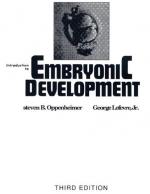|
This section contains 1,136 words (approx. 4 pages at 300 words per page) |

|
An embryo is a stage in the development of an organism. The term can be applied to plants, invertebrate and vertebrate animals. Rather than consider development of the literally millions of species of organisms, here will be considered the embryo of the common North American leopard frog, Rana pipiens. The species has been studied extensively because it is indeed common, it is relatively easy to induce ovulation in females, in vitro fertilization was first demonstrated in the species, and developmental progress can be monitored easily in a glass dish because the embryo is neither within a shell (as in reptiles and birds) nor within the body of the mother as in mammals. Development is arbitrarily divided into an embryonic period which occurs prior to hatching from the jelly membranes that enclose the embryo, and larval development which is the period of the...
|
This section contains 1,136 words (approx. 4 pages at 300 words per page) |

|


